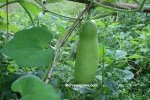There are crops which produce fruits and seeds mainly after undergoing cross-pollination, like corn, instead of self pollination.
Knowing the inherent characteristics of any particular plant as to the natural mechanisms briefly discussed below should prove valuable to any one who wishes to engage in crop improvement.
Indeed, basic procedures on plant breeding have been designed according to the natural modes of pollination of crops.
Plant Mechanisms that Promote Cross-Pollination or Outcrossing
1. Imperfect (or unisexual) flowers and monoecy
The separation of the male sexual part (stamen) and the female part (pistil) into two separate flowers eliminates intrafloral pollination and favors outcrossing.
In monoecy (adj. monoecious), or monoecism, both imperfect flowers are borne on the same plant.
In many cucurbits (e.g. pumpkin and squash, melons, and gourds) the unpollinated pistillate flower looks like a miniature fruit with attached showy petals.
In corn or maize, a monoecious crop plant, the pistillate flowers are found in the tassel, commonly called a male inflorescence.
The tassel emerges upward from the terminal portion or tip of the stem (culm).
The staminate flowers are found on a modified, lateral (axillary) shoot consisting of an ear (an inflorescence) enclosed in a protective husk.
Consequently, corn is about 95% cross-pollinated and only 5% self-pollinated (Poehlman 1977).
2. Imperfect flowers and dioecy
The natural occurence of individual plants bearing either staminate or pistillate flowers ensures cross-pollination.
This phenomenon is called dioecy (adj. dioecious).

The bottle gourd (Lagenaria siceraria) is a dioecious plant.
Like corn or maize (Zea mays), it has separate pistillate flowers (commonly called female flower) and staminate flowers (commonly called male flower) on the same plant.
In a population, this separation of the pistillate and staminate flowers, along with simultaneous maturity, ensures that fruits develop after cross pollination.
Consequently, bottle gourd is considered a naturally cross-pollinated crop.
However, there are plant populations exhibiting modifications of dioecy which favors cross pollination.
- In gynodioecy, some individual plants bear pistillate flowers exclusively, while others have perfect flowers;
- in androdioecy, some plants have staminate flowers only while others have perfect flowers;
- in trioecy (e.g. papaya), there are three plant variants: some individual plants may have staminate flowers only, some with pistillate flowers only, and others with perfect flowers (Simpson 2010).
3. Dichogamy
Opposite of homogamy, the stamen and the pistil mature at different periods. There are two main types: protandry and protogyny.
In protandry, the stamens or anthers develop ahead and the pollen grains mature and are shed before the pistils or the stigma become mature and receptive.
This type of pollination occurs in many members of the family Asteraceae (Sunflower family), Apiaceae (Carrot family), and Campanulaceae (Bluebell family).
In protogyny, such as in some members of Chenopodiaceae (e.g. Suaeda; Simpson 2010) and avocado (Allard 1960), the pistils or stigma mature ahead of the stamens or anthers.
4. Chasmogamy
Opposite of cleistogamy, pollen is shed, the stigma becomes receptive, and pollination occurs when the flower opens (Contreras 2007).
The opening of the flower exposes the stigma to pollen from other flowers.
5. Hercogamy (or herkogamy)
This is the spatial separation of the male (stamens) and female (stigma) sexual organs within a flower.
In one type of hercogamy called heterostyly, the heights of stigmas relative to the stamens vary from flower to flower.
In enantiostyly, or enantiosmorphy, there are “left-handed” flowers in which the styles curve to the left and “right-handed” flowers with styles that curve to the right.
In both cases, at least one stamen usually curves towards the direction opposite to that of the style.
In both types of hercogamy, pollen will tend to be deposited on one side of a visiting insect’s body.
For example, pollen from a left-handed flower will likely stick to an insect’s right side.
This will favor pollination of a right-handed flower.
Consequently, it will promote cross-pollination between plants that differ in style curvature.
Movement hercogamy, another type of hercogamy, is the movement of floral parts due to some trigger mechanisms.
In the Mimulus of family Phyrmaceae, the stigmas rapidly close when touched by a visiting animal pollinator.
The closure of the stigmas prevents subsequent intrafloral self-pollination (Simpson 2010). (click here to read Plant Movements on separate window)
6. Self-sterility or self-incompatibility
Self-sterility is the inability of a plant to form functional gametes or sexual structures while self-incompatibility is a condition in which fertilization fails to occur between gametes from the same individual.
In both cases, self-pollination does not form a seed, and thus seeds that are formed necessarily arise from cross-pollination.
In many forage grasses like red clover, white clover and alfalfa, there is self-pollination.
But the rate of growth of the pollen tube within the stylar column and towards the ovule is slow so that the ovules may disintegrate before fertilization has taken place (Poehlman 1977).
7. Other mechanisms
Rye has perfect flowers.
However, Poehlman (1977) explained that the anthers usually extrude out of the flower and burst to release the pollen grains.
At the same time, the flowers are open for a prolonged period, thus favoring cross-pollination.
REFERENCES
- ALLARD RW. 1960. Principles of Plant Breeding. New York: John Wiley & Sons, Inc. 485 p.
- CONTRERAS S. 2007. Fundamentals of seed production I: Genetics, breeding and seed production. Retrieved Nov. 27, 2013 from http://seedbiology.osu.edu/HCS630_files/April%2012/Fund%20Seed%20Prod%201,%20text.pdf.
- POEHLMAN JM. 1977. Breeding Field Crops. Connecticut: AVI Publishing Co., Inc. 427 p.
- SIMPSON MG. 2010. Plant Systematics. 2nd ed. Burlington, MA: Elsevier Inc. 740 p.
